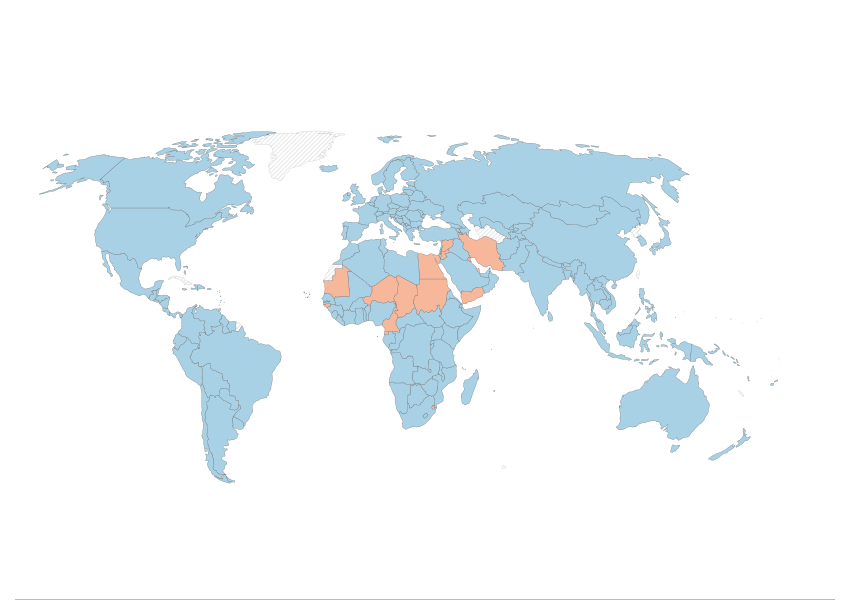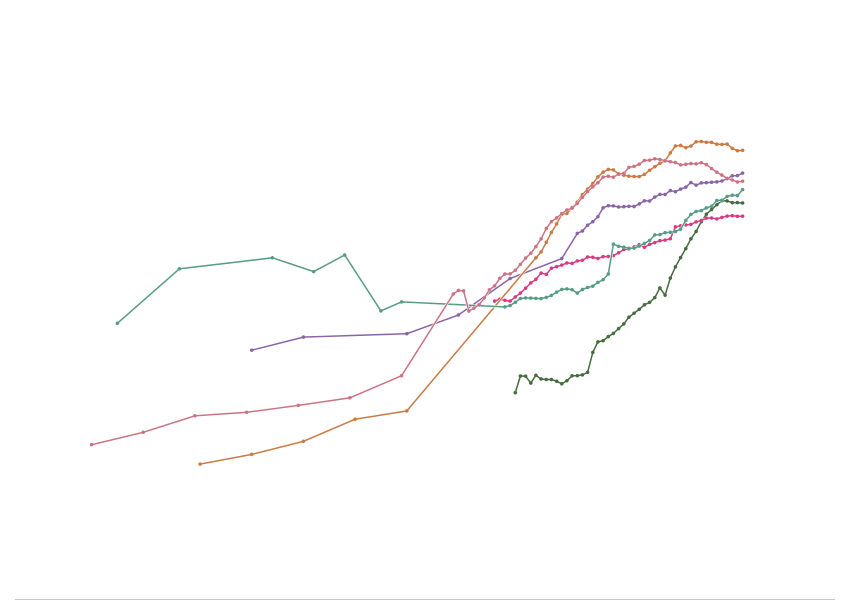Key facts about the gender pay gap
What is the gender pay gap? What does it tell us? Is it different from country to country? How does it change over time?
The 'gender pay gap' comes up often in political debates, policy reports, and everyday news. But what is it? What does it tell us? Is it different from country to country? How does it change over time?
Here we try to answer these questions, providing an empirical overview of the gender pay gap across countries and over time.
The gender pay gap measures inequality but not necessarily discrimination
The gender pay gap (or the gender wage gap) is a metric that tells us the difference in pay (or wages, or income) between women and men. It's a measure of inequality and captures a concept that is broader than the concept of equal pay for equal work.
Differences in pay between men and women capture differences along many possible dimensions, including worker education, experience and occupation. When the gender pay gap is calculated by comparing all male workers to all female workers – irrespective of differences along these additional dimensions – the result is the 'raw' or 'unadjusted' pay gap. On the contrary, when the gap is calculated after accounting for underlying differences in education, experience, etc., then the result is the 'adjusted' pay gap.
Discrimination in hiring practices can exist in the absence of pay gaps – for example, if women know they will be treated unfairly and hence choose not to participate in the labor market. Similarly, it is possible to observe large pay gaps in the absences of discrimination in hiring practices – for example, if women get fair treatment but apply for lower-paid jobs.
The implication is that observing differences in pay between men and women is neither necessary nor sufficient to prove discrimination in the workplace. Both discrimination and inequality are important. But they are not one and the same. (You can read about discrimination and 'equal pay for equal work' in our post here).
In most countries there is a substantial gender pay gap
Cross-country data on the gender pay gap is patchy, but the most complete source in terms of coverage is the United Nation's International Labour Organization (ILO). The visualization here presents this data. You can add observations by clicking on the option 'add country or region' at the bottom of the chart.
The estimates shown here correspond to differences between average hourly earnings of men and women (expressed as a percentage of average hourly earnings of men), and cover all workers irrespective of whether they work full time or part time.1
As we can see: (i) in most countries the gap is positive – women earn less than men; and (ii) there are large differences in the size of this gap across countries.
(NB. By this measure the gender wage gap can be positive or negative. If it is negative, it means that, on an hourly basis, men earn on average less than women. This happens in some countries, such as Malaysia.)
In most countries the gender pay gap has decreased in the last couple of decades
How is the gender pay gap changing over time? To answer this question, let's consider this chart showing available estimates from the OECD. These estimates include OECD member states, as well as some other non-member countries, and they are the longest available series of cross-country data on the gender pay gap that we are aware of.
Here we see that the gap is large in most OECD countries, but it has been going down in the last couple of decades. In some cases the reduction is remarkable. In the UK, for example, the gap went down from almost 50% in 1970 to about 17% in 2016.
These estimates are not directly comparable to those from the ILO, because the pay gap is measured slightly differently here: The OECD estimates refer to percent differences in median earnings (i.e. the gap here captures differences between men and women in the middle of the earnings distribution); and they cover only full-time employees and self-employed workers (i.e. the gap here excludes disparities that arise from differences in hourly wages for part-time and full-time workers).
However, the ILO data shows similar trends for the period 2000-2015.
The conclusion is that in most countries with available data, the gender pay gap has decreased in the last couple of decades.
The gender pay gap is larger for older workers
The United States Census Bureau defines the pay gap as the ratio between median wages – that is, they measure the gap by calculating the wages of men and women at the middle of the earnings distribution, and dividing them.
By this measure, the gender wage gap is expressed as a percent (median earnings of women as share of median earnings of men) and it is always positive. Here, values below 100% mean that women earn less than men, while values above 100% mean than women earn more. Values closer to 100% reflect a lower gap.
The next chart shows available estimates of this metric for full-time workers in the US, by age group.
First, we see that the series trends upwards, meaning the gap has been shrinking in the last couple of decades. Secondly, we see that there are important differences by age.
The second point is crucial to understand the gender pay gap: the gap is a statistic that changes during the life of a worker. In most rich countries, it’s small when formal education ends and employment begins, and it increases with age. As we discuss in our analysis of the determinants, the gender pay gap tends to increase when women marry and when/if they have children.
The gender pay gap is smaller in middle-income countries – which tend to be countries with low labor force participation of women
The scatter plot here shows available ILO estimates on the gender pay gap (vertical axis) vs GDP per capita (on a logarithmic scale along the horizontal axis). As we can see there is a weak positive correlation between GDP per capita and the gender pay gap. However, the chart shows that the relationship is not really linear. Actually, middle-income countries tend to have the smallest pay gap.
The fact that middle-income countries have low gender wage gaps is, to a large extent, the result of selection of women into employment. Olivetti and Petrongolo (2008) explain it as follows: “if women who are employed tend to have relatively high‐wage characteristics, low female employment rates may become consistent with low gender wage gaps simply because low‐wage women would not feature in the observed wage distribution.”2
Olivetti and Petrongolo (2008) show that this pattern holds in the data: unadjusted gender wage gaps across countries tend to be negatively correlated with gender employment gaps. That is, the gender pay gaps tend to be smaller where relatively fewer women participate in the labor force.
So, rather than reflect greater equality, the lower wage gaps observed in some countries could indicate that only women with certain characteristics – for instance, with no husband or children – are entering the workforce.
Keep reading on Our World in Data

Why is there a gender pay gap?
How did the sizable reductions in the gender pay gap in most high-income countries in recent decades come about? And why do substantial gaps remain?

How well do biological gender differences explain the gender pay gap?
What is the evidence for gender differences in wages stemming from biological sex differences?

Working women: Key facts and trends in female labor force participation
How has women’s participation in the labor force changed in recent decades? And why are these changes taking place?

Working women: What determines female labor force participation?
Gender differences in labor force participation have been narrowing substantially. Which key factors drive this change?
Acknowledgements
This article benefited greatly from research contributions provided by Sandra Tzvetkova.
Endnotes
There are some exceptions to this definition. In particular, sometimes self-employed workers, or part-time workers are excluded. You can explore these exceptions using the documentation files containing all the relevant indicator notes.
Olivetti, C., & Petrongolo, B. (2008). Unequal pay or unequal employment? A cross-country analysis of gender gaps. Journal of Labor Economics, 26(4), 621-654.
Cite this work
Our articles and data visualizations rely on work from many different people and organizations. When citing this article, please also cite the underlying data sources. This article can be cited as:
Esteban Ortiz-Ospina (2018) - "Key facts about the gender pay gap". Published online at OurWorldInData.org. Retrieved from: 'https://staging-owid.netlify.app/six-facts-pay-gap' [Online Resource]BibTeX citation
@article{owid-six-facts-pay-gap,
author = {Esteban Ortiz-Ospina},
title = {Key facts about the gender pay gap},
journal = {Our World in Data},
year = {2018},
note = {https://staging-owid.netlify.app/six-facts-pay-gap}
}Reuse this work freely
All visualizations, data, and code produced by Our World in Data are completely open access under the Creative Commons BY license. You have the permission to use, distribute, and reproduce these in any medium, provided the source and authors are credited.
The data produced by third parties and made available by Our World in Data is subject to the license terms from the original third-party authors. We will always indicate the original source of the data in our documentation, so you should always check the license of any such third-party data before use and redistribution.
All of our charts can be embedded in any site.

